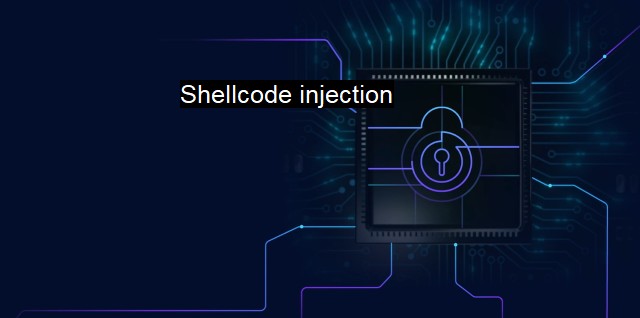What is Shellcode injection?
The Significance and Challenge of Shellcode Injection in Cybersecurity Defense Against Malware Attacks
Shellcode injection is a technique primarily employed in cybersecurity breaches, within which arbitrary codes are inserted into a software system to exploit a vulnerability. Widely used by attackers, these shellcodes can implement destructive programs into an innocent-looking software algorithm or infrastructure. Be it redoing the behavior of the targeted software system, revealing users' data, backdoor opening, or spyware activation, shellcode injection is often a nightmare scenario for any antivirus measures.Shellcode refers to a small piece of code used as the payload in the exploitation of software vulnerabilities. The name arose from the primary function of this code: bringing up a command shell from which the attacker can control the compromised machine. Despite the implications of its name, shellcodes do not signify placing an operating system shell. Instead, shellcodes symbolize the injection of any custom codes into the exploitation process of any applications' vulnerability.
Shellcodes come in different forms based on various parameters. shellcodes can be categorized by the architecture. Shellcodes written for a Windows platform cannot function on Linux systems, due to differences in system calls and memory organization, leading to segmentation faults or worse. Similarly, shellcodes can differ based on their function. In some instances, shellcodes may grant a remote shell back to the attacker, while others could be designed to create a new user account with specific privileges on the targeted machine or system.
Shellcode injection is a significant security concern due to the severity of the damage it can inflict. Once a shellcode gets injected into a system, it offers an avenue for remote attackers to manipulate or extract data, exploiting it as they see fitting.
With shellcode injection, the target system infection typically follows a sequence of steps starting with gaining an understanding of the machine's vulnerabilities. Attackers then run the shellcode on the host to rectify it based on the architecture and vulnerability of the target program or machine. Later, in the execution phase, attackers exploit code errors like input validation errors or buffer overflows to inject and execute arbitrary code on a victim's machine.
For all the harmful potential it contains, methods exist to combat shellcode injection. There are currently a range of preventive and responsive measures targeted at such security breaches.
First, secure coding practices, most prominently input validation, can reduce the risk of shellcode injection attacks. By ensuring data input into an application is well-structured and safe, developers can help prevent potential shellcode injections.
Antivirus software increasingly includes solutions designed to prevent shellcode injection attacks or mitigate their effects. Antivirus software executes in a privileged system level, monitoring applications and processes for potentially malicious behavior suggesting a possible injection.
Intrusion detection systems (IDSs) and intrusion prevention systems (IPSs) play crucial roles in an organization's security arsenal, capable of detecting suspicious activities that may reveal the presence of an injected shellcode within the digital environment.
Shellcode obfuscation, achieved via encode or transform operations, has become a recent trend favoring attackers. the security community counteracts this by applying machine learning and artificial intelligence methodologies to quickly discern valid from malicious scripts.
Shellcode injection is a considerable threat to cybersecurity, providing remote attackers with access to sensitive data and system control. through robust security systems, skilled developers, and advanced machine learning applications, the harmful potential of shellcodes can be minimized. No computer system is invulnerable, but shellcode injection risks can be significantly reduced. Regular updating, monitoring, and judicious practices surrounding data input can turn the tide in the favor of effective cybersecurity.

Shellcode injection FAQs
What is shellcode injection?
Shellcode injection is a technique used by cybersecurity attackers to insert malicious code into a running process of a targeted system. This code, also known as shellcode, is designed to execute various actions like stealing data or giving remote access to the attacker.What are the consequences of a successful shellcode injection attack?
The consequences of shellcode injection can vary, but they often include data theft, unauthorized access, and system takeover. This can lead to sensitive information being compromised or loss of control over the system, potentially causing damage to the organization or its reputation.Why is shellcode injection hard to detect?
Shellcode injection is hard to detect because it usually doesn't add any new files to the system or modify existing ones. Instead, it injects malicious code directly into a legitimate process, making it difficult for antivirus software to identify it as malicious.What measures can be taken to protect against shellcode injection attacks?
To protect against shellcode injection attacks, organizations can use a combination of security measures such as keeping their systems and software up to date, implementing access controls, using antivirus and endpoint detection and response (EDR) software, and conducting regular security audits to identify vulnerabilities. Additionally, user education and awareness can also help prevent attackers from gaining access to the system.| | A | | | B | | | C | | | D | | | E | | | F | | | G | | | H | | | I | | | J | | | K | | | L | | | M | |
| | N | | | O | | | P | | | Q | | | R | | | S | | | T | | | U | | | V | | | W | | | X | | | Y | | | Z | |
| | 1 | | | 2 | | | 3 | | | 4 | | | 7 | | | 8 | | |||||||